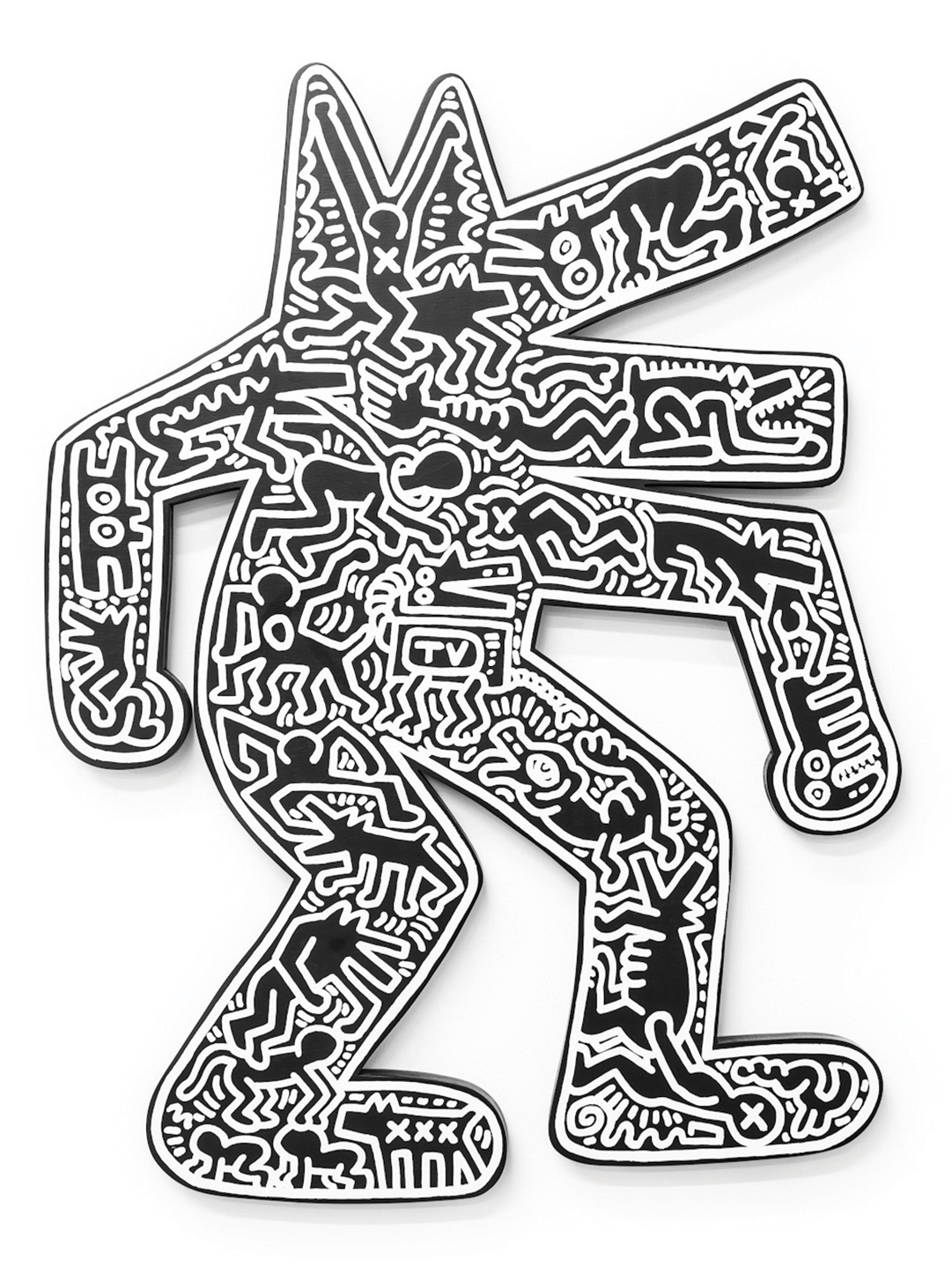
Keith Haring, Dog, 1986, painted plywood with silkscreen, 49 1/2 x 37 3/4 x 1 1/2 in. Courtesy of Mana Contemporary.
By Mary Hrbacek
Keith Haring’s large-scale symbolic scrawled diptychs, on view at Mana Contemporary, spur memories of an era when gangs of boys performed spontaneous break-dances in Soho subway stations. They recall a time when free spirits ruled, with street art that continues to spark the cosmic desire in the human soul to soar unfettered, taking those feelings beyond the back fence into society at large. Most trends die when their time is due; while his time may be past, Haring’s works continue to tap the universal underpinnings that make some art eternally present. They are neither shop-worn nor outmoded; luckily, fun is never out of style, and this show is nothing if not an expression of raucous fun. It provides a glimpse of the kind of the humorous kids’ antics that stir joy in one’s heart as they bring a snicker to one’s lips. Behind the identity of the carefree perpetually teenage street performer lurks a highly sophisticated artist who preferred to substitute the walls of public buildings for stretched canvases, whenever possible.
Keith Haring’s “graffiti” style was completely personal and individualistic. It doesn’t seem relevant to explore whether the works are drawings rather than paintings. The current show of wall-length diptychs on canvas permits the viewer to contemplate Haring’s intensely infectious iconography, which is steeped in historical references drawn from the art of indigenous people of Mesoamerica. The labyrinthine cartoon-like forms within forms articulate the personal thoughts and inner states of being that Haring’s world-view embodies. The pieces communicate a rhythm and vibrancy mirroring that of the b-boys break dancing on the streets and in the parks of lower Manhattan.
Haring’s imagery spans the gamut of boys running, babies crawling, dogs barking, and atoms spinning. His love of speedy action is expressed in straight motion-lines, often drawn in the wake of images of boys chasing one another. His visual world is packed with jubilant movement that he intertwines in configurations of line drawings where figures hop, do somersaults, dance with dogs, punch each other, and generally mock stillness. In one large ominous diptych, Haring scribbles on a figure that has developed a television for a head, symbolically telegraphing his view of the consequences of TV overexposure. He riffs on stick-figure forms one expects from a child’s hand, morphing them into witty and symbolically-matured art.
Haring’s ingenuity extends to include his use of random materials. In his acrylic diptych on leather, Unititled (1983) he creates a cutout shape that contains a personal parallel universe of multiple meanings, drawn with primary and secondary colored lines. Here Haring’s amusing analogies and ingenious associations excel brilliantly. While the pure colors conjure images of plastic play toys, the elaborate serpentine structure of interlocking shapes highlights his Mesoamerican inspiration superbly. The facial features of a group of interlocking boys are rendered with a simple cross that rivals the simplicity of Cycladic art. The lightning bolts drawn on the boys’ torsos evoke the presence of a soaring feeling of inner life force. In a hilarious image, a pregnant woman sports rolls of stomach fat while arrows point outward, indicating that she will grow even larger; her legs form a “smiley face” as they press against each other. Haring’s humor is sly. The dog/dragon’s teeth are expressed as the teeth of a comb. With some patient decoding, these works yield rich moments. In an oil and day-glow linear piece, a comical dog is caught chasing its tail. Haring’s painterly instincts come to the fore with the color shifts that render its paws in illusionistic motion with the utmost lack of pretention.
Haring’s Dog (1986) may be the star of the show. This hybrid dog-man, the artist in disguise, contains all the experiences and feelings of a lifetime, drawn in symbols and signs, within the skin of the barking dog. Boys riding dogs, bronco style, crawling dog-headed babies, dog-men riding dog babies, television-headed men, horse-men mimicking centaurs; it is all here. It is the visual poetry of a Dickensian urchin turned streetwise-action-leader of the troupe. His infectious exuberance echoes through his art. The spirit of Haring cannot be contained within four gallery walls but we get a good sense of the wealth of iconography created by an uncompromising artist who was active in a period perfectly attuned to the message he was out to send: wake up to the joy of life!























